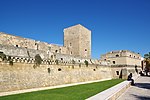Roman Catholic Archdiocese of Bari-Bitonto
Archbishops of BariBitontoDioceses established in the 4th centuryRoman Catholic dioceses in Apulia

The Roman Catholic Archdiocese of Bari-Bitonto (Latin: Archidioecesis Barensis-Bituntina) is Metropolitan Latin rite archbishopric in the administrative Bari province, Puglia (Apulia) region, southeastern Italy (the 'Heel'), created in 1986, when the historical diocese of Bitonto was subsumed in the Archdiocese of Bari.
Excerpt from the Wikipedia article Roman Catholic Archdiocese of Bari-Bitonto (License: CC BY-SA 3.0, Authors, Images).Roman Catholic Archdiocese of Bari-Bitonto
Piazza dell'Odegitria, Bari San Nicola
Geographical coordinates (GPS) Address Nearby Places Show on map
Geographical coordinates (GPS)
| Latitude | Longitude |
|---|---|
| N 41.128333333333 ° | E 16.868333333333 ° |
Address
San Giacomo
Piazza dell'Odegitria
70122 Bari, San Nicola
Apulia, Italy
Open on Google Maps









